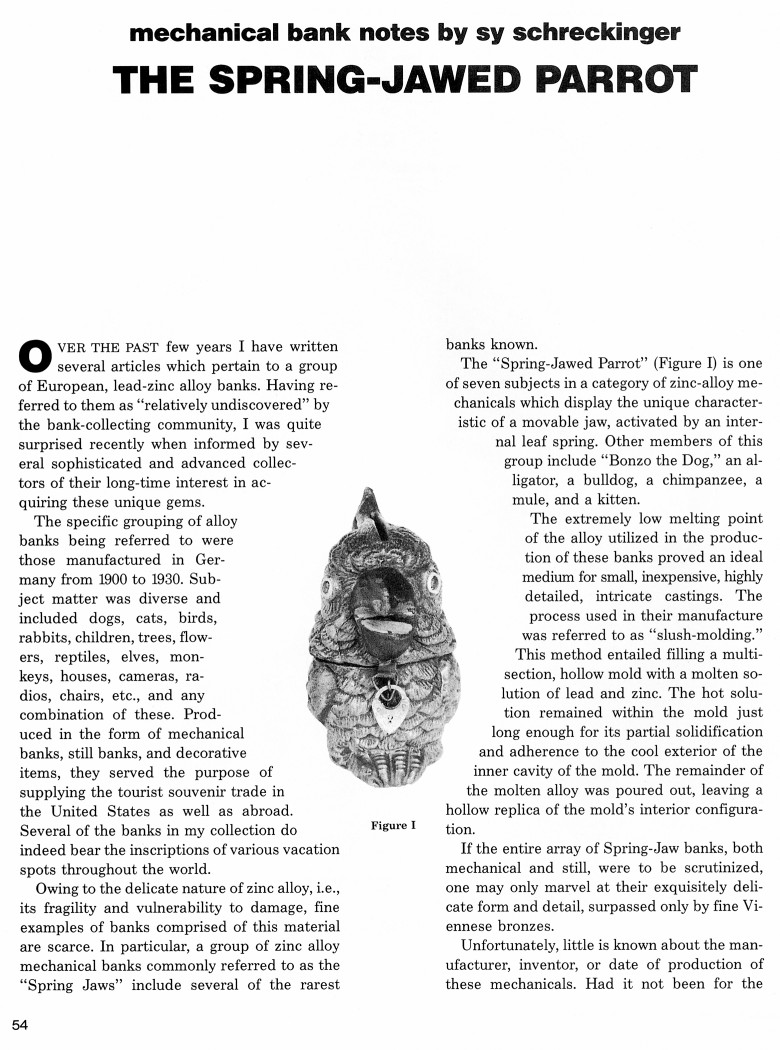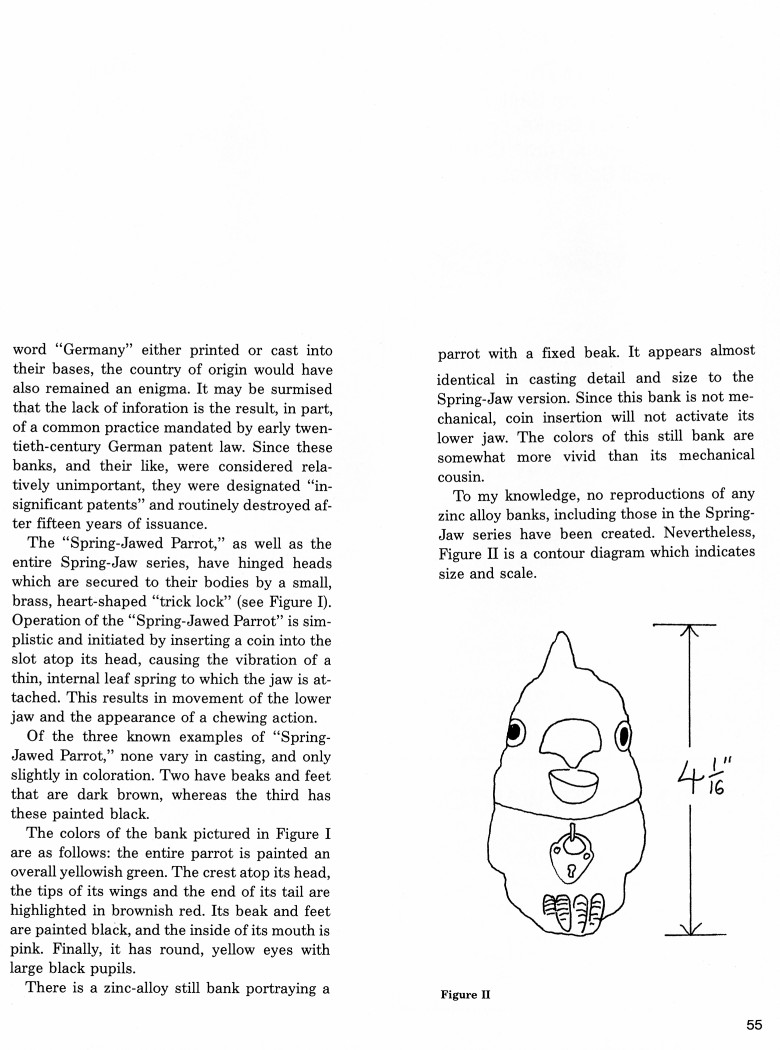|
The Spring-Jawed Parrot
by Sy Schreckinger – ANTIQUE TOY WORLD Magazine – July, 1991
Over the past few years I have written several
articles which pertain to a group of European, lead-zinc alloy banks.
Having referred to them as "relatively undiscovered" by the
bank-collecting community, I was quite surprised recently when informed by
several sophisticated and advanced collectors of their long-time
interest in acquiring these unique gems.
The specific grouping of alloy banks being referred to were those
manufactured in Germany from 1900 to 1930. Subject matter was diverse and
included dogs, cats, birds, rabbits, children, trees, flowers, reptiles,
elves, monkeys, houses, cameras, radios, chairs, etc., and any combination
of these. Produced in the form of mechanical banks, still banks, and
decorative items, they served the purpose of supplying the tourist
souvenir trade in the United States as well as abroad. Several of the
banks in my collection do indeed bear the inscriptions of various vacation
spots throughout the world.
Owing to the delicate nature of zinc alloy, i.e., its fragility and
vulnerability to damage, fine examples of banks comprised of this material
are scarce. In particular, a group of zinc alloy mechanical banks commonly
referred to as the "Spring Jaws" include several of the rarest banks
known.
The "Spring-Jawed Parrot" (Figure I) is one of seven subjects in a
category of zinc-alloy mechanicals which display the unique characteristic
of a movable jaw, activated by an internal leaf spring. Other members of
this group include "Bonzo the Dog," an alligator, a bulldog, a
chimpanzee, a mule, and a kitten.
The extremely low melting point of the alloy utilized in the
production of these banks proved an ideal medium for small, inexpensive,
highly detailed, intricate castings. The process used in their manufacture
was referred to as "slush-molding." This method entailed filling a
multi-section, hollow mold with a molten solution of lead and zinc. The
hot solution remained within the mold just long enough for its partial
solidification and adherence to the cool exterior of the inner cavity of
the mold. The remainder of the molten alloy was poured out, leaving a
hollow replica of the mold's interior configuration.
If the entire array of Spring-Jaw banks, both mechanical and still,
were to be scrutinized, one may only marvel at their exquisitely delicate
form and detail, surpassed only by fine Viennese bronzes.
Unfortunately, little is known about the manufacturer, inventor, or
date of production of these mechanicals. Had it not been for the word
"Germany" either printed or cast into their bases, the country of origin
would have also remained an enigma. It may be surmised that the lack of
information is the result, in part, of a common practice mandated by early
twentieth-century German patent law. Since these banks, and their like,
were considered relatively unimportant, they were designated
"insignificant patents" and routinely destroyed after fifteen years of
issuance.
The "Spring-Jawed Parrot," as well as the entire Spring-Jaw series,
have hinged heads which are secured to their bodies by a small, brass,
heart-shaped "trick lock" (see Figure I). Operation of the "Spring-Jawed
Parrot" is simplistic and initiated by inserting a coin into the slot
atop its head, causing the vibration of a thin, internal leaf spring to
which the jaw is attached. This results in movement of the lower jaw and
the appearance of a chewing action. Of the three known examples of
"Spring-Jawed Parrot," none vary in casting, and only slightly in
coloration. Two have beaks and feet that are dark brown, whereas the third
has these painted black.
The colors of the bank pictured in Figure I are as follows: the
entire parrot is painted an overall yellowish green. The crest atop its
head, the tips of its wings and the end of its tail are highlighted in
brownish red. Its beak and feet are painted black, and the inside of its
mouth is pink. Finally, it has round, yellow eyes with large black pupils.
There is a zinc-alloy still bank portraying a parrot with a fixed
beak. It appears almost identical in casting detail and size to the
Spring-Jaw version. Since this bank is not mechanical, coin insertion will
not activate its lower jaw. The colors of this still bank are somewhat
more vivid than its mechanical cousin.
To my knowledge, no reproductions of any zinc alloy banks, including
those in the Spring-Jaw series have been created. Nevertheless, Figure II
is a contour diagram which indicates size and scale.
|


